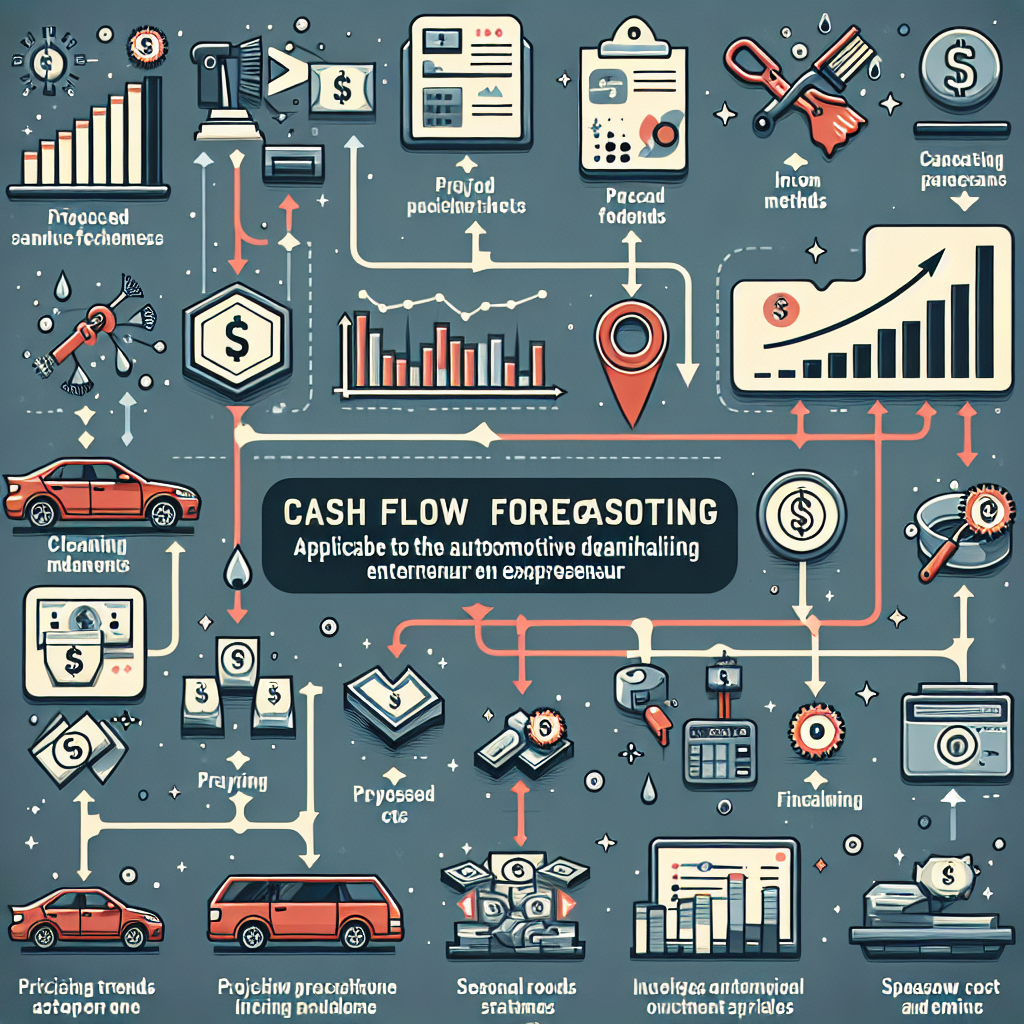Understanding Your Revenue Streams
Identifying Key Services
In my journey as an auto detailing entrepreneur, I quickly learned the importance of recognizing all my revenue streams. Every car service you offer can play a significant role in your cash flow. It’s not just about washes or waxes; don’t underestimate services like interior detailing, engine cleaning, or specialty treatments.
By creating a list of all the services I provide, I could see where I earn the most. Some services might take longer or require more effort, but they could also bring in more income. This made it crucial for me to understand what my clients were most interested in.
Regularly revisiting and even tweaking this list based on client feedback keeps my business aligned with what the market demands. After all, the more I tailor my services to my customers, the better my cash flow forecast might look!
Analyzing Pricing Strategies
Next up in my process was pricing. When I began, I was nervous about charging what I thought was a fair price. Yet, it’s essential to be confident in what your services are worth. Researching competitors and understanding the quality benchmarks in your area helped me set competitive yet profitable pricing.
Also, I learned to consider different pricing strategies, like package deals or seasonal promotions, to encourage customers to spend more. For instance, during summer, I might offer a “summer shine package” that combines several treatments at a discount. This not only boosts sales but also helps in planning my cash flow over those months.
Being clear about my pricing, and ensuring it aligns with my expenses and revenue goals, allows me to make more accurate forecasts. It’s about finding that right balance between value and profit!
Forecasting Seasonal Trends
Every entrepreneur knows that business can be cyclical, and auto detailing is no different. I took the time to track my sales and identify peak times of the year. For example, I noticed that spring and summer were massive for car detailing due to people prepping for vacations and road trips.
By mapping out these seasonal trends, I can anticipate cash flow surges and dips. If I expect lower business during winter, I plan ahead to save, so I don’t get caught off guard. It’s all about looking ahead and preparing for the slow days.
Utilizing historical data and analyzing past cash flow trends was a game-changer for me. Now, I’m not just reacting but proactively managing my finances!
Setting Up a Cash Flow Spreadsheet
Creating the Spreadsheet
Honestly, when I first started managing my cash flow, a simple spreadsheet did wonders for me. I set up one that tracked all my income and expenses. It may sound basic, but getting everything in one place helped me visualize my finances like never before!
My go-to columns include the date, service provided, income received, and any expenses incurred. By laying everything out, I could easily see patterns and manage my day-to-day spending better. Plus, spreadsheets are super flexible; I could tweak them based on what worked or didn’t.
Sometimes, I even include a column for predicted income, which helps me gauge whether I’m on track. It’s like having a financial roadmap to guide me through each month!
Updating Regularly
But it doesn’t stop at just creating the spreadsheet. I made it a routine to update my cash flow spreadsheet regularly—weekly, if possible. This helps me stay on top of any sudden changes in my income or expenses. It’s a habit that pays off, trust me!
If a client cancels an appointment or additional expenses arise, I’ve got a current picture of my finances, so I can quickly adjust my forecasts. Regular updates keep my predictions accurate and give me the confidence to make informed business decisions.
This practice has allowed me to align my strategy with reality, enhancing my ability to pivot when necessary.
Understanding the Cash Flow Cycle
Grappling with cash flow isn’t just about recording numbers; it’s about understanding the lifecycle of that cash. I took the time to discern how long it typically takes for money to come in after providing services.
For me, it often involved waiting for clients to pay post-service or on invoices terms. Knowing this cycle has enabled me to manage my expenses efficiently. For instance, if I know I’ll receive payment in a few weeks, I might hold off on large purchases until that money lands in my account.
This deeper understanding has taught me to track not only my incoming cash but also when I might need to make short-term financing decisions, like using a credit line for equipment purchases or hiring temporary help. Understanding this cycle keeps me afloat during those naturally low cash flow periods.
Utilizing Financial Software Tools
Choosing the Right Software
As my auto detailing business grew, spreadsheets started to feel limiting. That’s when I discovered financial software tools. These programs can automate many aspects of cash flow management, from tracking income and expenses to generating forecasts.
I took my time to research various software options. User-friendly interfaces and helpful features, like automated invoicing and expense tracking, were high on my list. Finding a good fit for my business made my life so much easier.
These tools also make generating financial reports a breeze. Instead of going through piles of paper, I can get a real-time overview of my cash flow situation without the headache. It streamlined my processes, allowing me to focus more on what I love—detailing cars!
Integrating with Other Business Tools
One of the best parts about using financial software is how it often integrates with other business tools I use. For example, my scheduling tool syncs with my financial software, so every appointment automatically updates my cash flow records.
This kind of integration reduces the likelihood of errors that come with manual entries and helps me keep all my business data cohesive. Plus, it saves me a ton of time, which I can invest in marketing or learning more about the auto detailing industry.
Connecting these tools created a well-oiled machine for my business operations, making management more efficient and enjoyable!
Leveraging Analytics and Reporting
Once I got comfortable using financial software, I started delving into the analytics and reporting features. These insights have been a game-changer. I can see trends over time, like which services generate the most revenue or which months tend to be my slowest.
By analyzing this data, I can make smarter business decisions. If I notice a drop in income during a typically busy month, I can strategize how to promote certain services or even price them differently to ramp up sales. Data-driven decisions feel so much more empowering!
This analytical approach has enabled me to forecast my cash flow confidently and set realistic financial goals for my auto detailing business.
Engaging with Clients for Cash Flow Consistency
Building Strong Client Relationships
Finally, I can’t stress enough how vital strong relationships with clients are in maintaining healthy cash flow. Happy clients are more likely to return and recommend my services to others. This word-of-mouth brings in organic growth, which helps with maintaining steady income.
I’ve found that personal touches, like follow-up emails after a job or post-service surveys, have built loyalty among my customer base. They appreciate my attention to detail, and it establishes trust, leading to repeat business.
This consistent engagement also helps me better understand my client’s needs, allowing me to adapt my offerings as necessary, which directly impacts my cash flow.
Implementing Loyalty Programs
To further foster client relationships, I decided to implement a loyalty program. Offering discounts for repeat customers or referrals boosts their chances of returning and spending more. These programs create a win-win situation for both parties.
As I rolled out my loyalty program, I noticed an uptick in repeat visits, which positively impacted my cash flow forecasts. Knowing I can rely on these clients to return helps in planning financial strategies better!
Furthermore, I track the performance of these programs closely. It’s crucial to know which incentives resonate most with customers to keep refining and improving them.
Communicating Clearly about Payments
Transparent communication regarding payment policies has also been a game-changer. By outlining payment expectations upfront, I minimize any confusion later on. Whether it’s deposits or payment due dates, being upfront sets a standard for clients.
Additionally, I’ve made it easier for clients to pay through various methods, including mobile payments or online invoices. Reducing friction in this area keeps the cash flowing smoothly!
By maintaining clear communication, I ensure a healthier cash flow cycle, enhancing my overall financial stability.
Frequently Asked Questions
1. How often should I update my cash flow forecast?
It’s best to update your cash flow forecast at least monthly or even weekly if you have fluctuations in income or expenses. Keeping your data fresh helps in making timely decisions!
2. What tools can assist with cash flow forecasting?
Financial software tools like QuickBooks, Xero, or even simple spreadsheet software like Google Sheets can help you track and forecast cash flow effectively.
3. How can I improve my cash flow management?
Focusing on understanding your revenue streams, regularly updating your cash flow spreadsheet, and building strong relationships with clients can significantly improve cash flow management.
4. Why are seasonal trends important for forecasting?
Seasonal trends help entrepreneurs anticipate the peaks and troughs in business, allowing them to plan financially for busy and slow periods.
5. How can analytics enhance my forecasting efforts?
Analytics provides insights into historical data and business performance trends. This information is vital for making informed projections about future cash flows.



